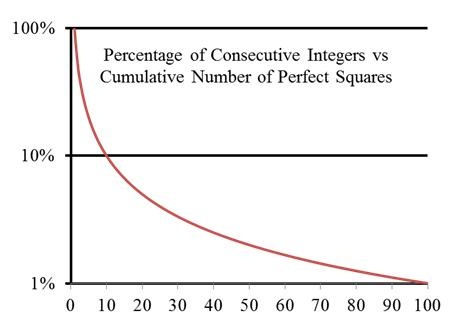|
Rational
Roots
Meanwhile, the general word "root" has been appropriated for the question above to represent taking the Nth root of an integer I to produce a root R, such that R N = I, and R can be either rational or irrational...
by Paul DeCelle. Published here by permision of the artist. Cube Root: With N = 3, R represents the cube root of I, such that for I = 27, R = 3, and for I = 9, R = 2.080083823..., which is an irrational number.The opening question,"What percentage of integers have Rational Roots?" is tantamount to asking, "What percentage of integers are perfect integer powers?" Taking perfect squares for starters, we find only three (1, 4, 9) in the first ten integers and three (16, 25, 36) in the next thirty integers, so perfect squares are not especially abundant. Indeed, the 'numerical distance' between successive perfect squares can be derived as follows: I 2 - (I - 1) 2 = I 2 - (I 2 - 2 I + 1) = 2 I -1,...which can be converted into a percentage of integers = 100 / (2 I -1) and seen to decrease as I increases toward infinity and eventually 100 / (2 I -1) vanishing to zero. Thus, 0% is the answer to the question, at least for N = 2. Here is a graphical representation, showing that the first 10 perfect squares are subsumed by 10% of the corresponding consecutive integers and the first 100 perfect squares are subsumed by 1% of the corresponding consecutive integers (a mouthful not likely to be welcome at a cocktail party).
For N = x,
we merely take
notice that I X =
I
X - 2 I
2, so by a generalized
version of the same formula,
the percentage of integers that have Rational Roots
tends to zero for all values of x.
Something of a paradox, it seems. Not unlike Paradox Lost (and found).
Let there be two irrational numbers A and B. Given the formula C = B A...
|
 hat
hat


